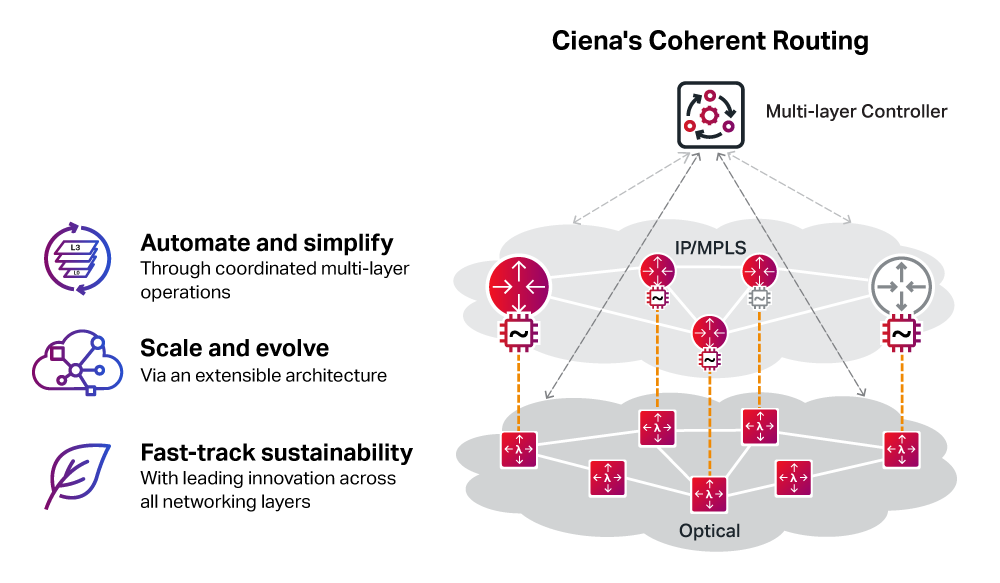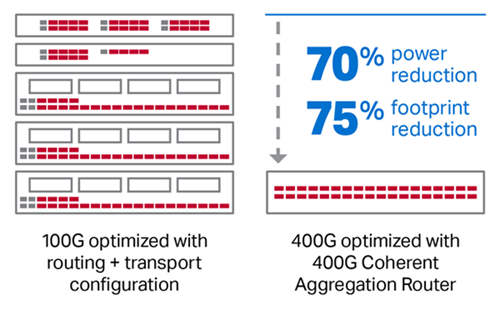There’s way more to IP/Optical convergence than just a plug in a router. Scott McFeely Ciena’s SVP of Global Products & Services explains how combining the best in IP, coherent optics, flexible photonics, and multi-layer control and automation can deliver real performance and sustainability advantages for network operators in a cloud-driven, always-connected world.
I want to let you in on a little secret. For a long time, some in our industry have oversimplified the thinking around IP/Optical convergence. They focused on how plugs in routers and a hop-by-hop architecture could simplify networks and reduce costs. But in practicality, most large operators took a close look, modeled the architecture, and quickly realized that this view was too narrow and impractical for broad adoption. We know because we have heard this from our customers around the world.
Now, I don’t want to be hyperbolic about hop-by-hop architectures. They have their place in the network. It’s suitable for applications requiring simple point-to-point connectivity and moderate capacity demands. But as 5G becomes mainstream, bandwidth consumption explodes, faster and faster on-ramps to the cloud are required, and any-to-any connectivity has become a critical requirement, customers have discovered that hop-by-hop is not the answer.
Coherent routing: The answer to converging your networks
Here at Ciena, we’ve consistently said that a new approach is needed to achieve the outcomes operators want from converging the IP and optical layers of their networks.
Why? Well, when you get past the industry noise and really think about deploying a converged network, you realize IP/Optical convergence involves more than just routers and coherent plugs. It requires an approach that’s about addressing the broad and demanding needs of today’s metro networks by delivering the greatest performance and achieving sustainability improvements, while still realizing the real cost benefits that have garnered network convergence so much attention.
We believe the right approach is coherent routing.
Coherent routing: understanding the critical elements
So, what are the components needed in an effective coherent routing approach to successfully evolve to and realize the benefits of IP/Optical convergence?
Think about when you build a house, you can’t complete the project with just a nail and a piece of wood, equally, you can’t reduce network convergence down to combining only two pieces of technology. Of course, you still need routers and coherent plugs, but as we have said all along, an intelligent, ROADM optical foundation, that underpins the flexible, programmable connectivity needed in today’s networks, is also required. The network needs to be able to scale for years to come – handle new traffic flows, extend to new locations, and easily evolve to next-gen Ethernet rates and coherent technologies – all while keeping power usage in check. These are the benefits customers have been realizing from their ROADM networks over the past 15 years and expect - and need - to retain in converged networks moving forward. From a sustainability perspective alone, studies show that as networks fill with capacity, a flexible photonic underlay using ROADM provides 30-50% power savings compared to a hop-by-hop architecture.
An effective coherent routing approach must have best-in-class routers, coherent plugs, and intelligent, flexible photonics. But that’s not all.
In my discussions with customers, it always comes back to the need to see the bigger picture with coordinated, multi-layer operations delivered through advanced software control and automation.
Coordinated multi-layer operations are so critical because IP/Optical convergence is about bringing the operational processes of two networks together. In fact, from our point of view, a winning strategy is centered around analyzing, coordinating, and controlling the IP and Optical layers of the network together to extract maximum value and efficiencies from all network layers. This is why coordinated multi-layer operations play a central role in Ciena’s Coherent Routing.
“With our new future-forward, multi-layer network, we’re well equipped to handle the cloudification of apps and services and provide our enterprise and residential customers with tuned performance, optimized SLAs and unsurpassed quality of experience.”
Ciena's Coherent Routing
At Ciena, we are hyper-focused on helping our customers extract maximum value from their converged networks. That’s why our Coherent Routing solution combines the best in coherent optics, optimized line systems, lean IP, and sophisticated software control and automation, allowing you to easily manage your converged network and optimize performance across a multi-vendor infrastructure.
Ciena’s Coherent Routing is made up of:
- MCP Applications, now known as Navigator Intelligent Apps – developed in tandem with our IP and optical platforms, MCP Apps provide integrated planning and powerful analytics that span network layers – and what’s unique to Ciena, is that we allow operators to visualize all this within a single pane of glass. By working from a unified view of your converged architecture, you can easily and intelligently plan your network and dynamically allocate resources to adjust capacity based on demand – all at the lowest operating cost – and quickly troubleshoot issues to deliver the best customer experience.
- Purpose-built coherent routers – after bringing one of the industry’s first coherent capable routers to market in 2019, we have continued to work with our customers to develop innovative new products and now offer a broad line-up of coherent capable routing platforms, driven by our next-gen IP NOS, to address use cases ranging from pole mounted coherent access all the way to the coherent aggregation in the metro core. With Ciena’s purpose-built coherent routers operators can reimagine their architecture and positively impact the economics of their metro and aggregation networks.
- WaveLogicTM 5 Coherent Optics – as the recognized industry leader in reliable coherent solutions, we provide our customers with the broadest range of coherent technology choices integrated with our coherent routers, allowing them to match requisite optical performance to their application and gain best network economics. These include hardened 200G pluggables for access, interoperable 400ZR for metro DCI, higher performance 400G pluggables compatible with existing metro ROADM networks or performance-optimized 800G when higher capacity connectivity is needed.
Through our vertical integration and resulting co-optimized design, our WaveLogic 5 products deliver lower energy consumption than competitive offerings, benefits of extended reach that minimizes regeneration, fewer site visits, and a simpler network.
- Optimized photonic line systems – to ensure your converged network can easily extend to new locations and evolve to support future generations of coherent technology, our solution leverages Ciena’s flexible, self-configurable photonic underlay. With embedded instrumentation and programmability, Ciena’s intelligent photonics support application-responsive networking to unleash ultimate scalability and flexibility when managing IP traffic flows.

“Ciena’s Coherent Routing allows us to efficiently scale to meet our customers’ growing bandwidth needs for things like transport, mobile backhaul and commercial broadband—and do so at a lower cost per bit.”
Achieving the sustainability benefits of IP/Optical convergence
A key promise of convergence has always been reduced costs and faster time to market. But multi-layer convergence is also intended to help Mother Nature by reducing the infrastructure footprint, space, and power required by the network.
We have been innovating for years to make this a reality – across our routing and switching platforms, photonic line systems, and of course, our coherent optics. With Ciena’s Coherent Routing, our customers can realize the compounded sustainability benefits these innovations can deliver.
For example, evolving the network from a 100G-optimized configuration to a 400G-optimized coherent routing architecture results in a 75% reduction in footprint and a 70% reduction in power. This is just one example. Upgrading from previous generations of technologies can result in even greater OPEX savings.

Break the status quo
We know not everyone will have the same strategy when it comes to IP/Optical convergence – and that’s okay. But nobody can afford to move backwards to the time when you couldn’t see or control the optical layer after converging it into the router. It’s clear that a holistic approach, leveraging best in IP, coherent optics, and flexible photonics, but driven by coordinated multi-layer operations is a must.
It’s only by working from a unified view of your converged architecture that you can easily and intelligently control any-to-any connectivity. Once you have this single view, you can start to unlock the real power of convergence and deliver a better customer experience.






